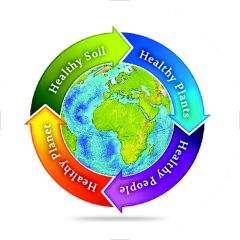Soil Erosion
macronutrients to the soil, NatureSoil Products return Macronutrients; Micronutrients; Necessary minerals like calcium, iron, magnesium, selenium, and many others; Enzymes; Natural plant growth hormones; And beneficial microorganisms (biota). NatureSoil Products deliver greater bioavailability of all nutrients compared to fertilizers and composts.
about the same rate as it erodes. Naturally, as a tree or leaves fall, or as plants die, natural organisms eat that dead vegetation decomposing it back into natural
topsoil. Human activity has been the main cause of erosion dating back to the first millenium. Human activity causes 10 times more soil erosion than all natural
processes combined. Agriculture, construction, and landfill waste are the main sources of human caused erosion. In the U.S., soil erosion occurs at 10 times the
rate at which topsoil is naturally replaced. With human activity, trees are cut down and processed into paper, cardboard, etc. and often disposed of into landfills.
Even when recycled into other paper products, that wood pulp is not returned to the ground as topsoil. As lawns are mowed and fallen leaves are raked, they are
most often bagged and disposed of as garbage, ending up in landfills. Again, that vegetation is not allowed to naturally decompose back into topsoil.
existing matter extracted from the earth’s soil, water, and atmospheric gasses like carbon dioxide. Every ounce of new vegetative matter that grows consumes an
equal amount of pre-existing matter, much of that coming from soil. Human activities such as farming, lawn mowing, shrub pruning, weeding, etc., when those
vegetative matters are removed from their source, all cause soil erosion. The United States throws away up to 40% of all it’s food produced, with the majority of that
food going to landfills, displacing that vegetative matter, and causing erosion.
Landfills rely on an extremely slow, anaerobic decomposition process that produces greenhouse gasses like methane and carbon dioxide. Landfills cause both air pollution and water pollution. Studies have shown that people living close to landfills suffer from lung and heart diseases from the toxic gasses that are released from the landfill degradation. Seemingly harmless materials, such as yard waste, paper products, food waste, etc., when combined with the other materials disposed of in landfills (metals, batteries, pharmaceuticals, cosmetics, plastics, etc.) combine to create a toxic leachate. Groundwater contamination may result from leakage of very small amounts of leachate. TCE is a carcinogen typically found in landfill leachate. It would take less than 4 drops of TCE mixed with the water in an average swimming pool (20,000 gallons) to render the water undrinkable. Some surveys conducted have shown that 82% of the landfills have leaks and up to 41% of the landfills had a leak area of more than one square foot. EPA sponsored research shows that burying household garbage in the ground poisoned the ground water. The EPA has stressed that, even with the double liner landfills, the probability of leaking is very high. According to EPA estimates a 100-acre landfill in the northeastern United States can produce 57 million gallons of leachate every year. The largest landfill in the world – Fresh Kills, in Staten Island, NY – is over 2965 acres, and produces 4 million gallons of leachate per day, or 1.5 billons gallons per year.
